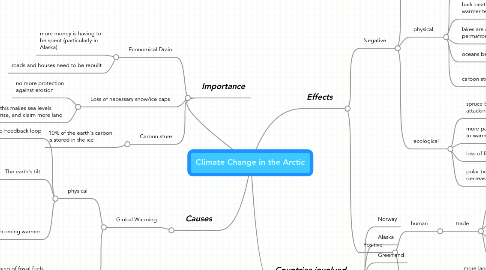
1. Importance
1.1. Economical Drain
1.1.1. more money is having to be spent (particularly in Alaska)
1.1.2. roads and houses need to be rebuilt
1.2. Loss of necessary snow/ice caps
1.2.1. no more protection against erosion
1.2.2. this makes sea levels rise, and claim more land
1.3. Carbon store
1.3.1. 10% of the earth's carbon is stored in the ice
2. Causes
2.1. Global Warming
2.1.1. physical
2.1.1.1. Albedo Feedback loop
2.1.1.1.1. permafrost melting
2.1.1.2. The earth's tilt
2.1.1.2.1. every few thousand years the earth's tilt alters so the poles are in different positions
2.1.1.2.2. This gradual change in the direction of the earth's axis, called precession is responsible for changes in the climate
2.1.1.3. Oceans becoming warmer
2.1.1.3.1. Over thousands of years the oceans change temperature
2.1.1.3.2. Currently, the temperature is warmer than a century ago
2.1.2. human
2.1.2.1. burning of fossil fuels
2.1.2.2. realease of greenhouse gases
2.1.2.2.1. The energy sector is responsible for about ¾ of the carbon dioxide emissions, 1/5 of the methane emissions and a large quantity of nitrous oxide.
3. Effects
3.1. Negative
3.1.1. human
3.1.1.1. homes and places of work are often lost to flooding/land mass moving
3.1.1.2. simple pasttimes like Husky racing are being effected due to lack of snow
3.1.2. physical
3.1.2.1. loss of trees as supporting permafrost is melting
3.1.2.2. more trees are being lost due to spruce bark beatles being able to survive in warmer temperatures
3.1.2.3. lakes are disappearing as permafrost is melting
3.1.2.4. oceans becomming warmer
3.1.2.4.1. change in current
3.1.2.5. carbon stores are being released
3.1.2.5.1. this results in more greenhouse gases, and therefore more warming
3.1.3. ecological
3.1.3.1. spruce bark beatles attacking forests
3.1.3.2. more parasites can live due to warmer temperatures
3.1.3.3. loss of fish (salmon)
3.1.3.4. polar bear population decreasing by 30%
3.2. Positive
3.2.1. human
3.2.1.1. trade
3.2.1.1.1. tourism
3.2.1.1.2. fishing trade increasing
3.2.1.1.3. more cod due to warmer seas
3.2.1.1.4. unemployment is decreasing
3.2.2. ecological
3.2.2.1. more land is available for construction
3.2.2.2. more fish (cod)
4. Countries involved
4.1. Norway
4.2. Alaska
4.3. Greenland
4.4. Finland
4.4.1. all of these being involved makes it harder to manage - coordination between countries is poor
